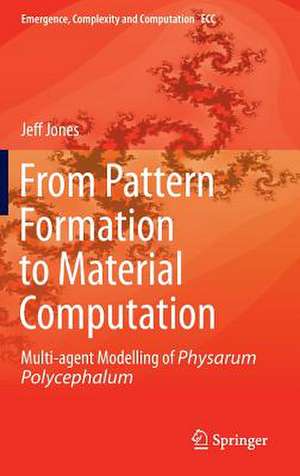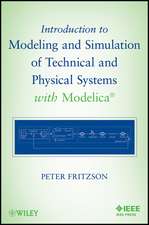From Pattern Formation to Material Computation: Multi-agent Modelling of Physarum Polycephalum: Emergence, Complexity and Computation, cartea 15
Autor Jeff Jonesen Limba Engleză Hardback – iun 2015
In its conclusion the book moves beyond Physarum and provides results of scoping experiments approximating other complex systems using the multi-agent approach. The results of this book demonstrate the power and range of harnessing emergent phenomena arising in simple multi-agent systems for biological modelling, computation and soft-robotics applications. It methodically describes the necessary components and their interactions, showing how deceptively simple components can create powerful mechanisms, aided by abundant illustrations, supplementary recordings and interactive models. It will be of interest to those in biological sciences, physics, computer science and robotics who wish to understand how simple components can result in complex and useful behaviours and who wish explore the potential of guided pattern formation themselves.
| Toate formatele și edițiile | Preț | Express |
|---|---|---|
| Paperback (1) | 934.55 lei 6-8 săpt. | |
| Springer International Publishing – 19 oct 2016 | 934.55 lei 6-8 săpt. | |
| Hardback (1) | 940.98 lei 6-8 săpt. | |
| Springer International Publishing – iun 2015 | 940.98 lei 6-8 săpt. |
Din seria Emergence, Complexity and Computation
- 8%
 Preț: 397.83 lei
Preț: 397.83 lei - 18%
 Preț: 1132.65 lei
Preț: 1132.65 lei - 18%
 Preț: 946.72 lei
Preț: 946.72 lei - 20%
 Preț: 651.75 lei
Preț: 651.75 lei - 20%
 Preț: 570.97 lei
Preț: 570.97 lei - 15%
 Preț: 653.33 lei
Preț: 653.33 lei - 15%
 Preț: 648.24 lei
Preț: 648.24 lei - 15%
 Preț: 651.19 lei
Preț: 651.19 lei -
 Preț: 392.37 lei
Preț: 392.37 lei - 15%
 Preț: 647.59 lei
Preț: 647.59 lei - 15%
 Preț: 641.71 lei
Preț: 641.71 lei - 15%
 Preț: 645.28 lei
Preț: 645.28 lei - 15%
 Preț: 649.06 lei
Preț: 649.06 lei - 18%
 Preț: 1415.22 lei
Preț: 1415.22 lei - 20%
 Preț: 1304.44 lei
Preț: 1304.44 lei - 20%
 Preț: 1296.18 lei
Preț: 1296.18 lei - 20%
 Preț: 655.35 lei
Preț: 655.35 lei - 15%
 Preț: 648.56 lei
Preț: 648.56 lei - 18%
 Preț: 953.82 lei
Preț: 953.82 lei - 20%
 Preț: 657.02 lei
Preț: 657.02 lei - 18%
 Preț: 1117.03 lei
Preț: 1117.03 lei - 20%
 Preț: 992.26 lei
Preț: 992.26 lei - 15%
 Preț: 656.74 lei
Preț: 656.74 lei - 20%
 Preț: 649.60 lei
Preț: 649.60 lei - 15%
 Preț: 654.43 lei
Preț: 654.43 lei - 20%
 Preț: 661.14 lei
Preț: 661.14 lei - 20%
 Preț: 645.47 lei
Preț: 645.47 lei - 20%
 Preț: 658.19 lei
Preț: 658.19 lei - 20%
 Preț: 644.15 lei
Preț: 644.15 lei - 18%
 Preț: 880.77 lei
Preț: 880.77 lei - 20%
 Preț: 1455.75 lei
Preț: 1455.75 lei - 20%
 Preț: 1158.26 lei
Preț: 1158.26 lei
Preț: 940.98 lei
Preț vechi: 1176.22 lei
-20% Nou
Puncte Express: 1411
Preț estimativ în valută:
180.05€ • 188.50$ • 148.98£
180.05€ • 188.50$ • 148.98£
Carte tipărită la comandă
Livrare economică 05-19 aprilie
Preluare comenzi: 021 569.72.76
Specificații
ISBN-13: 9783319168227
ISBN-10: 3319168223
Pagini: 385
Ilustrații: XVI, 370 p. 209 illus., 145 illus. in color.
Dimensiuni: 155 x 235 x 27 mm
Greutate: 0.72 kg
Ediția:2015
Editura: Springer International Publishing
Colecția Springer
Seria Emergence, Complexity and Computation
Locul publicării:Cham, Switzerland
ISBN-10: 3319168223
Pagini: 385
Ilustrații: XVI, 370 p. 209 illus., 145 illus. in color.
Dimensiuni: 155 x 235 x 27 mm
Greutate: 0.72 kg
Ediția:2015
Editura: Springer International Publishing
Colecția Springer
Seria Emergence, Complexity and Computation
Locul publicării:Cham, Switzerland
Public țintă
ResearchCuprins
Part I Slime Mould Physarum polycephalum. Part II Modelling Physarum polycephalum..- Part III Material Computation in a Multi-agent Model of Physarum polycephalum: Mechanisms and Applications.- Part IV From Emergent Oscillations to Collective Transport and Amoeboid Movement.- Part V Conclusions and Beyond Physarum models.
Recenzii
“The book presents a full account of research andwill be extremely useful for young and early career researchers exploring thetopic of both multiagent modeling and the slime mold. … I found the book auseful tool for teaching students how agent-based modeling works, itscomplexities, and how it can be used to extend our knowledge of complex modelsto build better and reliable structures inspired by nature.” (Mariam Kiran, ComputingReviews, November, 2015)
Textul de pe ultima copertă
This book addresses topics of mobile multi-agent systems, pattern formation, biological modelling, artificial life, unconventional computation, and robotics. The behaviour of a simple organism which is capable of remarkable biological and computational feats that seem to transcend its simple component parts is examined and modelled. In this book the following question is asked: How can something as simple as Physarum polycephalum - a giant amoeboid single-celled organism which does not possess any neural tissue, fixed skeleton or organised musculature - can approximate complex computational behaviour during its foraging, growth and adaptation of its amorphous body plan, and with such limited resources? To answer this question the same apparent limitations as faced by the organism are applied: using only simple components with local interactions. A synthesis approach is adopted and a mobile multi-agent system with very simple individual behaviours is employed. It is shown their interactions yield emergent behaviour showing complex self-organised pattern formation with material-like evolution. The presented model reproduces the biological behaviour of Physarum; the formation, growth and minimisation of transport networks.
In its conclusion the book moves beyond Physarum and provides results of scoping experiments approximating other complex systems using the multi-agent approach. The results of this book demonstrate the power and range of harnessing emergent phenomena arising in simple multi-agent systems for biological modelling, computation and soft-robotics applications. It methodically describes the necessary components and their interactions, showing how deceptively simple components can create powerful mechanisms, aided by abundant illustrations, supplementary recordings and interactive models. It will be of interest to those in biological sciences, physics, computer science and robotics who wish to understand how simple components can result in complex and useful behaviours and who wish explore the potential of guided pattern formation themselves.
In its conclusion the book moves beyond Physarum and provides results of scoping experiments approximating other complex systems using the multi-agent approach. The results of this book demonstrate the power and range of harnessing emergent phenomena arising in simple multi-agent systems for biological modelling, computation and soft-robotics applications. It methodically describes the necessary components and their interactions, showing how deceptively simple components can create powerful mechanisms, aided by abundant illustrations, supplementary recordings and interactive models. It will be of interest to those in biological sciences, physics, computer science and robotics who wish to understand how simple components can result in complex and useful behaviours and who wish explore the potential of guided pattern formation themselves.
Caracteristici
Examines and models the behavior of a simple organism which is capable of remarkable biological and computational features that seem to transcend its simple component parts Addresses topics of mobile multi-agent systems, pattern formation, biological modelling, artificial life, unconventional computation, and robotics Methodically describes the necessary components and their interactions, showing how deceptively simple components can create powerful mechanisms, aided by abundant illustrations, supplementary recordings and interactive models Asks the following question: How can something as simple as Physarum do such complex things, and with such limited resources?












